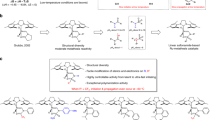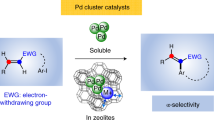Abstract
Ruthenium-catalysed ring-closing metathesis (RCM) is a powerful technique for the preparation of medium-to-large rings in organic synthesis, but the details of the intimate mechanism are obscure. The dynamic behaviour of an RCM-relevant ruthenacyclobutane complex and its reactivity with ethene were studied using low-temperature NMR spectroscopy to illuminate the mechanism of this widely used reaction. These kinetic and thermodynamic experiments allowed for mapping the energy surface of the key steps in the RCM reaction as mediated by Grubbs-type catalysts for alkene metathesis. The highest barrier along the RCM path is only 65 kJ mol−1, which shows that this catalyst has extremely high inherent activity. Furthermore, this transition state corresponds to that connecting the intermediates in this reaction leading to ring opening of the cyclopentene product. This shows that ring closing is kinetically slightly favoured over ring opening, in addition to being driven by the loss of ethene.
This is a preview of subscription content, access via your institution
Access options
Subscribe to this journal
Receive 12 print issues and online access
$259.00 per year
only $21.58 per issue
Buy this article
- Purchase on Springer Link
- Instant access to full article PDF
Prices may be subject to local taxes which are calculated during checkout






Similar content being viewed by others
References
Conrad, J. C. & Fogg, D. E. Ruthenium-catalyzed ring-closing metathesis: recent advances, limitations and opportunities. Curr. Org. Chem. 10, 185–202 (2006).
Yee, N. K. et al. Efficient large-scale synthesis of BILN 2061,a potent HCV protease inhibitor, by a convergent approach based on ring-closing metathesis. J. Org. Chem. 71, 7133–7145 (2006).
Badjic, J. D. et al. The exclusivity of multivalency in dynamic covalent processes. Angew. Chem. Int. Ed. 43, 3273–3278 (2004).
Nielsen, T. E. & Schreiber, S. L. Towards the optimal screening collection: a synthesis strategy. Angew. Chem. Int. Ed. 47, 48–56 (2008).
Waldmann, H. Killing 84 birds with one stone. Nature Chem. Biol. 5, 76–77 (2009).
Schrock, R. R. Olefin metathesis by molybdenum imido alkylidene catalysts. Tetrahedron 55, 8141–8153 (1999).
Malcolmson, S. J., Meek, S. J., Sattely, E. S., Schrock, R. R. & Hoveyda, A. H. Highly efficient molybdenum-based catalysts for enantioselective alkene metathesis. Nature 456, 933–937 (2008).
Grubbs, R. H., Miller, S. J. & Fu, G. C. Ring-closing metathesis and related processes in organic synthesis. Acc. Chem. Res. 28, 446–452 (1995).
Sanford, M. S., Ulman, M. & Grubbs, R. H. New insights into the mechanism of ruthenium-catalyzed olefin metathesis reactions. J. Am. Chem. Soc. 123, 749–750 (2001).
Sanford, M. S., Love, J. A. & Grubbs, R. H. Mechanism and activity of ruthenium olefin metathesis catalysts. J. Am. Chem. Soc. 123, 6543–6554 (2001).
Trnka, T. M. & Grubbs, R. H. The development of L2X2Ru=CHR olefin metathesis catalysts: an organometallic success story. Acc. Chem. Res. 34, 18–29 (2001).
Labinger, J. A. & Bercaw, J. E. Understanding and exploiting C–H bond activation. Nature 417, 507–514 (2002).
Monfette, S. & Fogg, D. E. Equilibrium ring-closing metathesis. Chem. Rev. 109, 3783–3816 (2009).
Correa, A. & Cavallo, L. The elusive mechanism of olefin metathesis promoted by (NHC)Ru-based catalysts: a trade between steric, electronic, and solvent effects. J. Am. Chem. Soc. 128, 13352–13353 (2006).
Adlhart, C. & Chen, P. Mechanism and activity of ruthenium olefin metathesis catalysts: the role of ligands and substrates from a theoretical perspective. J. Am. Chem. Soc. 126, 3496–3510 (2004).
Benitez, D. & Goddard, W. A. The isomerization equilibrium between cis and trans chloride ruthenium olefin metathesis catalysts from quantum mechanics calculations. J. Am. Chem. Soc. 127, 12218–12219 (2005).
Straub, B. F. Origin of the high activity of second-generation Grubbs catalysts. Angew. Chem. Int. Ed. 44, 5974–5978 (2005).
Romero, P. E., Piers, W. E. & McDonald, R. Rapidly initiating ruthenium olefin-metathesis catalysts. Angew. Chem. Int. Ed. 43, 6161–6165 (2004).
Romero, P. E. & Piers, W. E. Direct observation of a 14-electron ruthenacyclobutane relevant to olefin metathesis. J. Am. Chem. Soc. 127, 5032–5033 (2005).
Wenzel, A. G. & Grubbs, R. H. Ruthenium metallacycles derived from 14-electron complexes. New insights into olefin metathesis intermediates. J. Am. Chem. Soc. 128, 16048–16049 (2006).
Romero, P. E. & Piers, W. E. Mechanistic studies on 14-electron ruthenacyclobutanes: degenerate exchange with free ethylene. J. Am. Chem. Soc. 129, 1698–1704 (2007).
Webster, C. E. Computational insights into degenerate ethylene exchange with a Grubbs-type catalyst. J. Am. Chem. Soc. 129, 7490–7491 (2007).
Dias, E. L., Nguyen, S. T. & Grubbs, R. H. Well-defined ruthenium olefin metathesis catalysts: mechanism and activity. J. Am. Chem. Soc. 119, 3887–3897 (1997).
van der Eide, E. F., Romero, P. E. & Piers, W. E. Generation and spectroscopic characterization of ruthenacyclobutane and ruthenium olefin carbene intermediates relevant to ring closing metathesis catalysis. J. Am. Chem. Soc. 130, 4485–4491 (2008).
Anderson, D. R., Hickstein, D. D., O'Leary, D. J. & Grubbs, R. H. Model compounds of ruthenium–alkene intermediates in olefin metathesis reactions. J. Am. Chem. Soc. 128, 8386–8387 (2006).
Anderson, D. R., O'Leary, D. J. & Grubbs, R. H. Ruthenium–olefin complexes: effect of ligand variation upon geometry. Chem. Eur. J. 14, 7536–7544 (2008).
Stewart, I. C. et al. Conformations of N-heterocyclic carbene ligands in ruthenium complexes relevant to olefin metathesis. J. Am. Chem. Soc. 131, 1931–1938 (2009).
Ritter, T., Hejl, A., Wenzel, A. G., Funk, T. W. & Grubbs, R. H. A standard system of characterization for olefin metathesis catalysts. Organometallics 25, 5740–5745 (2006).
Kumar, P. S., Wurst, K. & Buchmeiser, M. R. Ru-alkylidene metathesis catalysts based on 1,3-dimesityl-4,5,6,7-tetrahydro-1,3-diazepin-2-ylidenes: synthesis, structure, and activity. Organometallics 28, 1785–1790 (2009).
Piermattei, A., Karthikeyan, S. & Sijbesma, R. P. Activating catalysts with mechanical force. Nature Chem. 1, 133–137 (2009).
Perrin, C. L. & Dwyer, T. J. Application of two-dimensional NMR to kinetics of chemical exchange. Chem. Rev. 90, 935–967 (1990).
Naumov, S. & Buchmeiser, M. R. Comparative DFT study on the role of conformers in the ruthenium alkylidene-catalyzed ROMP of norborn-2-ene. J. Phys. Org. Chem. 21, 963–970 (2008).
Wiberg, K. B. The concept of strain in organic chemistry. Angew. Chem. Int. Ed. Engl. 25, 312–322 (1986).
Rowley, C. N., van der Eide, E. F., Piers, W. E. & Woo, T. K. DFT study of the isomerization and spectroscopic/structural properties of ruthenacyclobutane intermediates relevant to olefin metathesis. Organometallics 27, 6043–6045 (2008).
Jordan, R. B. Reaction Mechanisms of Inorganic and Organometallic Systems 3rd edn (Oxford Univ. Press, 2007).
Chemical Kinetics Simulator v.1.01 (IBM Almaden Research Center, San Jose, California, 1996).
Lee, J. B., Ott, K. C. & Grubbs, R. H. Kinetics and stereochemistry of the titanacyclobutane–titanamethylene interconversion. Investigation of a degenerate olefin metathesis reaction. J. Am. Chem. Soc. 104, 7491–7496 (1982).
Feldman, J., Davis, W. M., Thomas, J. K. & Schrock, R. R. Preparation and reactivity of tungsten(vi) metallacyclobutane complexes – square pyramids versus trigonal bipyramids. Organometallics 9, 2535–2548 (1990).
Sanford, M. S., Love, J. A. & Grubbs, R. H. A versatile precursor for the synthesis of new ruthenium olefin metathesis catalysts. Organometallics 20, 5314–5318 (2001).
Wakamatsu, H. & Blechert, S. A new highly efficient ruthenium metathesis catalyst. Angew. Chem. Int. Ed. 41, 2403–2405 (2002).
Bujok, R. et al. Ortho- and para-substituted Hoveyda–Grubbs carbenes. an improved synthesis of highly efficient metathesis initiators. J. Org. Chem. 69, 6894–6896 (2004).
Leitao, E. M., Dubberley, S. R., Piers, W. E., Wu, Q. & McDonald, R. Thermal decomposition modes for four-coordinate ruthenium phosphonium alkylidene olefin metathesis catalysts. Chem. Eur. J. 14, 11565–11572 (2008).
Hong, S. H., Wenzel, A. G., Salguero, T. T., Day, M. W. & Grubbs, R. H. Decomposition of ruthenium olefin metathesis catalysts. J. Am. Chem. Soc. 129, 7961–7968 (2007).
Acknowledgements
Funding for this work was provided by the Natural Sciences and Engineering Research Council of Canada in the form of a Discovery Grant to W.E.P. E.F.v.d.E. thanks the Alberta Ingenuity Fund for financial support in the form of a Studentship. Materia Inc. (Pasadena) is acknowledged for donation of the Grubbs second-generation catalyst I. The authors thank M. Gagné for useful discussions.
Author information
Authors and Affiliations
Contributions
E.F.v.d.E. and W.E.P. conceived and designed the experiments, E.F.v.d.E. carried out the experiments and E.F.v.d.E. and W.E.P. co-wrote the paper.
Corresponding author
Ethics declarations
Competing interests
The authors declare no competing financial interests.
Supplementary information
Supplementary information
Supplementary information (PDF 1114 kb)
Rights and permissions
About this article
Cite this article
van der Eide, E., Piers, W. Mechanistic insights into the ruthenium-catalysed diene ring-closing metathesis reaction. Nature Chem 2, 571–576 (2010). https://doi.org/10.1038/nchem.653
Received:
Accepted:
Published:
Issue Date:
DOI: https://doi.org/10.1038/nchem.653
This article is cited by
-
The driving force role of ruthenacyclobutanes
Theoretical Chemistry Accounts (2015)
-
The mechanics of metathesis
Nature Chemistry (2010)



